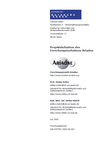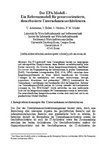Ariadne
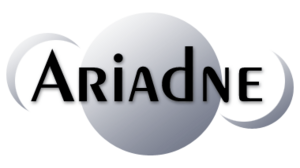
Ariadne Research Project
A generic process model for realising a flexible enterprise-wide IT architecture in the context of migration, integration and refactoring projects.
In the context of the proceeding globalisation major enterprises and even small and medium-sized enterprises (SME) must adjust their business strategy and business units to international markets. The main aspect of these markets is their dynamic character which claims a high degree of adaptability. On an operating level this demands a flexible IT architecture and applications with which processes, products and services can be mapped dynamically and individually fitted to the changing requirements. Therefore the object of the research project is the development of a generic process model with the goal of building an enterprise-wide IT architecture in the context of migration, integration and refactoring projects. On one hand ?generic? means that the model defines a main process with suitable phases and activities, which is instantiated to the according subproject and requirements of the specific enterprise. On the other hand the model delivers a fund of approaches such as guidelines, patterns and best practices to implement the subprocesses and activities. Out of this fund certain approaches are selected through defined evaluation criteria best suited for each case. The process model will be validated and gradually refined in certain projects within the Ariadne community.
Project Context
In the context of the proceeding globalisation major enterprises and even SMEs are confronted with intense, steadily growing and increasing internationalised markets. As a reaction to this new situation the enterprises can follow two basic strategies. One strategy is focusing consequently on internationalised markets with potential sales increase. Mainly this strategy is only realisable for SMEs through cooperations with international partners. Additionally the business proesses, products and services need to be created adaptable in order to spot them in flexible markets. The other strategy is to optimise the business processes with the potential of cost reduction on different levels. One first and essential step of cost reduction is an efficient arrangement of the internal processes. The second step consists of an enhancement of the processes between different enterprises to reduce the costs of all cooperating partners along a common value chain. The two strategies are complementary but an optimised competitiveness or value chain can be achieved through a ?good? arrangement in terms of the distribution and integration of the relevant subprocesses.
When realising both strategies, the enterprises are confronted on the operating level with the problem of missing flexibility of their enterprise-wide IT architecture and applications to accomplish both goals. This is the main reason why business processes, which are implemented within IT systems, can be arranged respectively to the demands of internationalised markets only with immense and not often justifiable expenses. Also the products and services which need to be arranged and rebuild into different versions can not be mapped easily onto the different IT systems because certain data structures and functions to maintain the different versions are not implemented either incorrectly or not at all.
Furthermore a continuously supported implementation of the internal and external processes of an enterprise, particularly regarding to SCM processes, requires a complete integration of the applications which are involved within a business process. This high degree of integration is very difficult to achieve because of the heterogeneity of the existing applications and platforms. This is especially true for SMEs because these enterprises do not have the financial capabilities to use expensive EAI tools and portal systems and furthermore the technical knowledge is mostly not present in these enterprises. Due to the same reasons the development of individualised IT applications or acquisition of packaged applications is not an option for SMEs.
Therefore the protection of investments for existing IT applications is essential and focuses on how to increase the flexibility of IT systems with the least amount of effort and to realise a flexible IT architecture. The main question for the enterprises and the supporting/consulting enterprises is how to plan, create and realise migration, integration and refactoring projects. Furthermore application vendors who have to integrate the applications into the enterprise-wide architecture of their customers, are confronted with the same set of problems.
The field of transformation, migration and integration of application systems is in scientific and practical scope for over 30 years now. Moreover the development cycles in hardware, operating systems, architectures etc. and the nonexistent integration of data and functions intensify these problems since the introduction of information systems on enterprise level. Embraced by the term ?reengineering? scientific approaches for process models, methods and tools are being developed within the scientific community. In practice multiple projects are developed whereas in particular the projects concerning the Y2K-problematic received a lot of attention in the reengineering field.
Project Goal
In context of multiple migration and integration paths many different problems occur because the sofware architecture and structure of information systems have changed from pure monolithic systems to a combination of different platforms such as standardised software, component-based systems, web-based systems and especially portal systems. Therefore the goal of this project is to develop a generic process model which will support enterprises with the built up of a flexible, enterprise-wide architecture and with the planning and implementation of migration, integration and refactoring projects. These projects are the main focus of the core processes of this model in terms of transformation respectively reengineering of the enterprise-wide architecture into a flexible one (see figure 2.1). Beside migration and integration activities the refactoring is also part of this research because the applications often need to be reengineered in order to migrate or integrate them. For these scenarios the ?wrapping technique? was developed to integrate legacy systems with web applications.
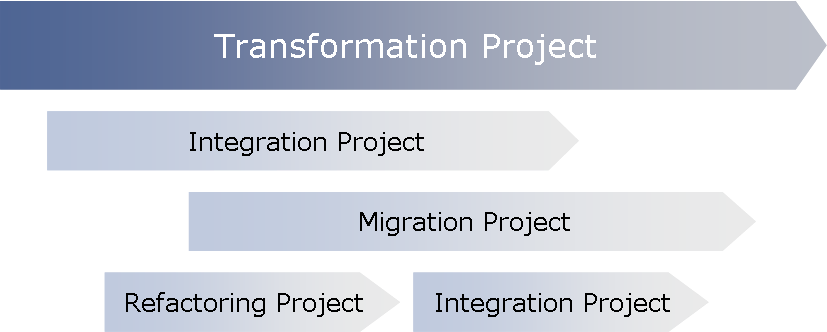
Within this research project the basic steps, activities and milestones of the process model will be developed to realise a flexible, enterprise-wide IT architecture. Further small process models (SPM) will be designed to implement the three core processes which will be implemented in the different subprojects. The different models contain a set of migration scenarios, technologies and levels, all specific in the context of either migration or integration. The refactoring model needs to build upon the two basic programming paradigms: procedural vs. object-oriented. Therefore this model is based on the extensive amount of research in the field of reengineering.
Not only the activities of the process model which structure the project but also the activities for the SPMs will be assigned to methods, approaches, guidelines, patterns and best practices in the next step. The elapsed time of this step will exceed the duration of this research project by building an Ariadne community where scientist and practitioneers will share their knowledge so that the existing experience will be emphasised. Also evaluation criteria will be developed for selecting methods and conceptual solutions for the specific subprojects. Furthermore ?manageable? evaluation criteria for software architectures are necessary for realising an adequate IT architecture with a focus on flexibility.
A high attention will be placed on effort estimation especially due to the limited financial scope and human resources of the SMEs. In addition an estimation model for the SPMs will be designed, which will not be based on the lines of codes (LoC) but furthermore on specified classes of complexity. Thus this estimation model will be improved throughout every concrete project within the Ariadne community.
Planning
The specified activities of this research project are assigned to different phases and work packages in the scope of project planning.
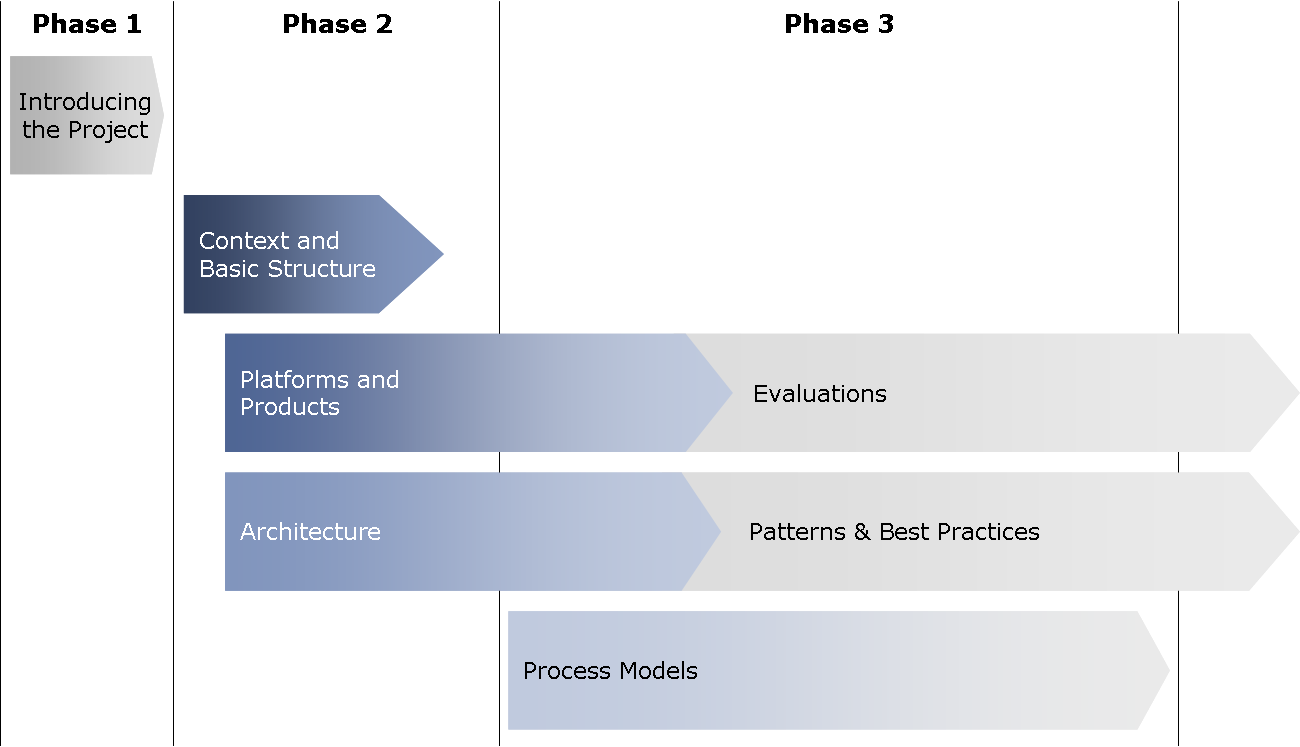
Work Packages
Within the work package "General Context and Characteristics" the conceptual structure of the project as well as the requirements concerning the project contents will be discussed. Further basic concepts and scenarios will be documented.
The package "Architecture" includes the documentation of the scientific state-of-the-art research activities and technologies in the field of IT architecture on application and enterprise level. Also the referencing and identification of patterns, best practices and models are part of this package. Another element is the development of evaluation criteria for software architecture with a focus on flexibility. In the "Platform and Products" package different products and platforms are examined such as Mainframe, .NET, J2EE and SAP. At the same time patterns and best practices are identified analogue to the "Architecture" package. Further platform architectures will be analyzed and products will be evaluated through the Softec Competence Lab. In terms of the process models the different migration, integration and refactoring scenarios are discussed and documented. Based on this evaluation basic scenario specific configurations are created.
The "Process Model" package contains the generic process model which defines the frame of transformation projects, where a flexible enterprise-wide IT architecture is built. Further small process models for migration, integration and refactoring activities are created. Each process model will be assigned to conceptual solution (patterns, best practices) on the different steps of the model (phases, activities and milestones). These solutions are either identified within the "Platforms and Products" package or within the "Process Model". Also best practices are identified within the generic process model and evaluation models support the decision process.
Organisation
The project structure is based on the work packages defined before.
The projects "General Context and Characteristics", "Architecture", "Platforms and Products" and "Process Models" result from the structure of the work packages. In addition the steering committee and the project management is identified.
The project organisation shows the coordinating personal of each project respectively to the steering committee and project management which is nominated by names. Further there are intentionally no other roles or personal identified.
Each member of this project is requested to take an active role in specifying and working on all of the packages. In particular it is recommended that members will be working on different projects/teams at the same time. Also the coordinating personal is called upon to be involved in other parts of this project.
The project organisation can be extended in order to integrate new research affiliates.
Benefits
The user groups of the global process model are general software users, software vendors and consulting enterprises. Therefore the models should open new business opportunities as well as for employment in the primary and secondary sectors of the software market.
The models assist the software users with the transformation and integration of theirs existing set of applications into a flexible IT architecture so that they can assure their position on the global markets of today.
Software vendors can ensure the market potential of their products and perhaps even strengthen this potential by including their products into the architecture of the different customers.
Consulting enterprises - especially small flexible ones - can develop new market potential by specialising on migration and integration scenarios. Certainly their potential in terms of employment and market share can be assumed as the greatest potential - particularly with a focus on SMEs as customers - because in general a nearshoring or offshoring is not feasable for them. Also the specialisation can lead to a higher potential on international markets for German consulting enterprises, even though their labour costs are higher compared to other consulting enterprises.
The Ariadne portal enables the three user groups to access the results of this research. The initiated community, which exceeds the three user groups, can use the established knowledge resource and expand it with their experience and knowledge they gained within their own projects. In particular the evaluation criteria and parameters for the estimation of investments will be improved within this process. Different edit forms and a database will be created in order to structure and to build up a feedback process within the portal.
Affiliate Concept
The affiliate concept of the Ariadne project envisions a cooperation with various enterprises and research facilities which will be integrated into the project through a continous research cycle (see figure 5.1).
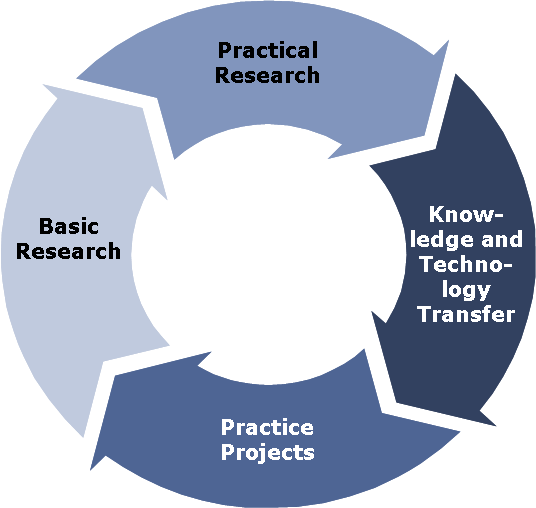
Based on the results of the basic research the goals of the Ariadne project will be handled in terms of the practical research and especially the enterprises will be integrated within this phase of the project. They participate in the structuring and refining process of the project goals as well as on the determination of the state of the art. They assist on identifying the areas where there is a certain need for methods and conceptual solutions but also take an active role in creating them and therefore arrange the knowledge and technology transfer into practice. Through the support of the project affiliates certain projects in practice can be identified in the early stage of the research cycle where the results can then be applied and validated. The phase of the knowledge and technology transfer passes the results to the cooperation partners. This early cooperation therefore ensures an effective transfer of the results into practice. These results are applied to a concrete project in practice with the effect that the project benefits directly from the research activities. At last the practical application and evaluation of the results initiate new impetus for the basic research as well as for the practical research.
- Eicker, Stefan; Malich, Stefan: Projektdefinition des Forschungsvorhabens Ariadne. Essen, 2005. AbstractPDFDetailsCitation
Im Kontext der fortschreitenden Globalisierung müssen nicht nur Großunternehmen, sondern auch kleine und mittlere Unternehmen (KMU) ihre Geschäftsstrategien auf internationale Märkte ausrichten. Wesentliches Charakteristikum dieser Märkte ist ihre ausgeprägte Dynamik, die von den Unternehmen eine entsprechend hohe Anpassungsfähigkeit erfordert. Diese setzt auf der operationalen Ebene flexible IT-Architekturen und -Anwendungen voraus, in denen Prozesse, Produkte und Dienstleistungen dynamisch auf die jeweiligen Anforderungen anpassbar abgebildet sind. Gegenstand des Forschungsprojekts ist deshalb die Entwicklung eines generischen Vorgehensmodells zum Aufbau einer flexiblen unternehmensweiten IT-Architektur im Rahmen von Migrations-, Integrations- und Refactoring-Projekten. ?Generisch? heißt dabei zum einen, dass das Modell einen Rahmenprozess mit entsprechenden Phasen und Aktivitäten definiert, der jeweils im Hinblick auf die konkreten Anforderungen eines Unternehmens sowie im Hinblick auf die durchzuführenden Teilprojekte ?instanziiert? wird. Zum anderen soll das Modell einen Fundus von Lösungsansätzen für die Durchführung der Teilprozesse und Aktivitäten in Gestalt von Leitfäden, Patterns und Best Practices bieten, aus denen jeweils die im konkreten Fall zu nutzenden Ansätze über entsprechende Bewertungskriterien ausgewählt werden. Das Vorgehensmodell soll in den konkreten Projekten der Ariadne-Community validiert und sukzessiv verfeinert werden.
- Ackermann, Ulf; Eicker, Stefan; Neuhaus, Sebastian; Schuler, Peter M.: Das EPA-Modell - Ein Referenzmodell für prozessorientierte, dienstbasierte Unternehmensarchitekturen. In: Lehner, F.; Nösekabel, H.; Kleinschmidt, P. (Ed.): Multikonferenz Wirtschaftsinformatik 2006, Tagungsband 2. GITO-Verlag, Berlin, 2006, p. 183-197. AbstractPDFDetailsCitation
Die IT-Landschaft vieler Unternehmen besteht aus heterogenen und inkompatiblen Einzelsystemen, deren Betrieb unverhältnismäßig hohe Kosten verursacht. Als Ursache dieser Integrationsproblematik identifiziert DAVENPORT die Fragmentierung der Informationen in großen Unternehmen. Verschiedene Lösungsansätze (EAI, SOA, GPM) versuchen diese Integrationsproblematik zu lösen. Jedoch beeinflussen die Ursachen ("changes in the marketplace, and strategic restructurings, through acquisitions, divestitures, and partnerships") kontinuierlich die Unternehmen - unabhängig vom bestehenden Grad der Integration. Anbieter von Unternehmenssoftware preisen als Lösung vermehrt serviceorientierte Lösungen an. Das EPA-Modell wurde entworfen, um eine umfassende Sicht auf die Integrationskonzepte für Unternehmenssysteme zu entwickeln. Die unterschiedlichen Integrationsansätze wurden dazu analysiert und in ein ganzheitliches Modell überführt. Der Name des Modells steht in Anlehnung an die Enterprise Service Architecture (ESA) für Enterprise Process Architecture (EPA).

